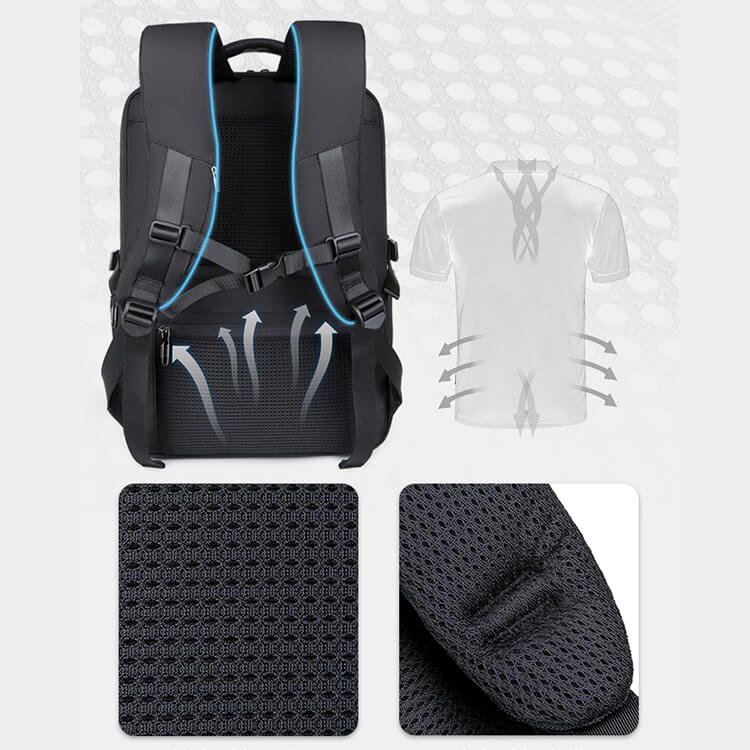The modern backpack shape may seem no different from those of backpacks from decades or even hundreds of years ago. In fact, in many aspects, backpack manufacturers have used modern ergonomic designs to make the weight distribution more reasonable when using backpacks, better protect our shoulders, backs, and waists, and reduce our physical fatigue and the risk of falling.
The following is a comprehensive analysis of the evolution of backpack shape and its ergonomic design, combined with the design changes and actual effects in recent decades:
I. Evolution of the backpack shape and functional goals
- From traditional carrying to dynamic carrying system
- Early form: Traditional backpacks mainly rely on shoulder straps to transfer weight to the spine, and long-term carrying can easily lead to shoulder and neck fatigue and spinal pressure.
- Exoskeleton and endoskeleton design:
- Exoskeleton (such as early military backpacks) transfers weight to the waist belt and pelvis through a metal frame, reducing spinal pressure, but it is bulky and costly.
- Endoskeleton (such as modern mountaineering bags) uses built-in metal rods or carbon fiber strips, combined with the waist belt to form a three-point support (sacrum and shoulder blades), improve stability and adapt to body curves.
- Adjustable trolley backpack: Combines the trolley and carrying functions, and realizes the switching between bending and straightening states through the articulated joint design, adapts to pitching movements and disperses back pressure.
- Partition and modular design
- Capacity and functional partition: Modern backpacks are often divided into main compartment, front pocket, side pocket and computer compartment. For example, student backpacks optimize book access through the height difference between the front and back pieces, and use denim and cotton and linen lining to balance durability and lightness.
- Modular expansion: Some outdoor bags achieve flexible storage through elastic side pockets or detachable accessories to meet the needs of multiple scenarios.
II. Actual effects and data support of ergonomic design
- Weight distribution and pressure relief
- Waist belt and shoulder strap synergy: Studies have shown that the waist belt can transfer 60%-80% of the backpack weight to the pelvis, significantly reducing shoulder muscle activity and subjective fatigue (Borg scale score reduced by 15%-20%).
- Weight threshold recommendation: Experiments show that backpack weight exceeding 15% of body weight will lead to abnormal gait (such as increased pelvic mobility and shortened stride length). It is recommended that daily carrying should not exceed 10%-15% of body weight.
- Dynamic monitoring and feedback system
- Smart backpack design: Real-time monitoring of carrying posture and weight through pressure sensors and IMU (inertial measurement unit), combined with vibration prompts to adjust posture. For example, a patented technology shows that such a design can reduce muscle fatigue by 30% and reduce the risk of scoliosis.
- Data verification: In the firefighter backpack study, the xPk® harness reduced walking energy consumption by 8% by bringing the load closer to the body’s center of gravity (COM), and significantly improved the user’s subjective comfort.
- Material and structure optimization
- Lightweight materials: Use high-density nylon (such as SumkBags) or carbon fiber skeletons to reduce self-weight and increase load-bearing capacity (some outdoor bags increase their load-bearing ratio by 40%).
- Breathable carrying system: The back contact surface adopts 3D mesh and suspension design to reduce sweat accumulation. Experiments show that it can reduce the back skin temperature difference by 2-3℃.

III. Design trends and user group adaptation
- Specialized segmentation
- Outdoor sports bag: Emphasis on load-bearing capacity and breathability, using exoskeleton or endoskeleton design, suitable for mountaineering, cycling and other scenes.
- Commuter and student bag: Focus on lightness and partitioning, such as adjustable straps and bottom reinforcement design to reduce the impact of book shaking on students’ spine.
- Business and fashion bag: Combined with PU leather or wrinkled nylon, it takes into account both beauty and practicality through minimalist lines and hidden functions (such as magnetic buckles).
- Sustainability and technology integration
- Recycled material application: For example, recycled nylon backpacks reduce environmental burden while maintaining wear resistance.
- Wearable technology integration: For example, backpacks linked to mobile phone APPs display load data in real time and provide health advice.
Ⅳ, unresolved issues and future directions
- Long-term health impact: Although ergonomic design has significantly improved comfort, long-term tracking data on adolescent spinal development is still insufficient.
- Cost and popularity: High-end smart backpacks have not yet been widely popularized due to the high cost of sensors and materials. Performance and price need to be balanced in the future.
Summary
Designers center backpack shape evolution on ergonomics. Dynamic carrying systems improve comfort and functionality. Intelligent monitoring features track load and posture in real time. Material innovations, like Cordura® and Dyneema®, reduce weight and boost durability. Experimental data show these systems lower energy consumption and disperse pressure evenly. Experts warn that we still need long-term studies on health effects. Cost optimization remains a key challenge for widespread adoption. Users can choose professional Backpack shape designs according to their needs. For example, outdoor users give priority to waist belt support, and students pay attention to lightweight and reasonable zoning.



